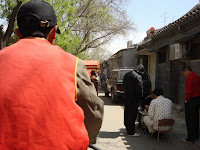Hutong means a lane or alley formed by lines of siheyuan (a compound with houses around a courtyard). During the dynasties the Forbidden City was surrounded in concentric circles by the Inner City and Outer City. Aristocrats lived in sihyuans close to the Forbidden City; commoners, merchants, artisans, and laborers lived farther out in siheyuans that were smaller in scale and simpler than those of the aristocrats. Our short tour of a Hutong gave us a glimpse of old Beijing. As we wound through the narrow passages we viewed people going about their daily lives. To cap off our visit we were treated to a wonderful meal and tour at one of the residences.
It's been interesting researching Hutongs as there appears to be lots of controversy concerning the preservation of these structures. Because Hutongs are in central Beijing they are prime real estate. In 60 years more than half the Hutongs have been demolished. Below is a quote from a member of the team which filmed the documentary, "Beijing's Vanishing Hutong".
Gentrification is a difficult issue for the hutongs. Of course the hutongs need money spent on them, and adding bathrooms and modern touches will significantly improve the lives of residents. That being said, most gentrification of the hutongs involves pulling down the old buildings and replacing them with faux hutongs. Residents describe these as soulless and missing any feeling of history. Gentrification also raises the prices and drives out traditional hutong residents. Gentrified hutongs are predominantly the homes of wealthier Chinese or foreigners which adds a greater disparity between older residents and their homes and the newer residents.




No comments:
Post a Comment